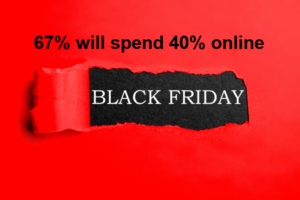
[ad_1]
By Jeff Domansky
With Black Friday imminent, we’ve got a rundown of predictions for the 2023 holiday shopping season kickoff from US retail analysts and research groups. Overall, projections are encouraging, with new record-level sales up from 2% to 4% over last year.
National Retail Federation upbeat

The National Retail Federation (NRF) expects record sales to increase by 3% to 4% over 2022, reaching nearly $966.6 billion through the holiday season.
“It is not surprising to see holiday sales growth returning to pre-pandemic levels,” NRF President and CEO Matthew Shay said in a news release. “Overall household finances remain in good shape and will continue to support the consumer’s ability to spend.”
The real news is the continued growth of online and other non-store sales, which should be up 7% to 9% over last year, reaching $278.8 billion – 28.8% of sales. NRF research estimated consumers would spend an average of $875 each on core holiday items, including gifts, decorations, food and other holiday-related purchases this year.
Medallia cites inflation’s impact

Research by Medallia says there may be some impact from inflation. Consumers told researchers they expect to spend 1% more than last year but on 4% fewer items. 60% of shoppers said budgeting for holiday shopping this year was more challenging due to inflation.
Shoppers expect to spend up to 5% more on the family but may spend up to 10% less on friends, neighbors, teachers and co-workers compared to 2022.
Mass retailers like Walmart, Target and Costco are expected to be the big winners, along with online-only retailers. 49% of shoppers said they will buy at mass retailers, followed by online-only such as Amazon (47%), department stores (25%), electronics stores (24%), apparel stores (22%), Club stores such as Costco and Sam’s Club (19%), beauty/cosmetic retailers (17%), dollar stores (16%), home improvement (15%), sporting goods (14%) and local retailers (12%).
Online shopping will also be strong, with 67% of consumers saying they expected to do 40% of their shopping online.
McKinsey: started early, will end later
While consumers are in fairly good financial shape, McKinsey Boston partner Tamara Charm sees two trends this year. “One difference is that consumers are very much in a trade-down mood. They were trading down last year, but this year, they’re doing so even more,” she said. Also, they’re stretching the holiday shopping season, starting earlier and expecting to finish later, where consumers think the best deals will be.

McKinsey New York partner Colleen Baum said 2023 has featured many ongoing promotions aimed at consumers. “The one other big difference from last year is we’re starting to see younger consumers really lead on new shopping behaviors: specifically much heavier emphasis on same-day delivery and on buy now, pay later [BNPL], as well as some willingness to pay for those types of conveniences and fulfillment options.”
Both consultants also expect to see consumers spending more on themselves for travel and self-care. Charm said 57% of Gen Z shoppers expect to use buy now pay later when shopping.
To the relief of bricks-and-mortar retailers, Baum said 87% of shoppers said they will shop in-store this year, and 12% will pick up goods in-store.
Shoppers are ready to shop
Shoppers are also enthusiastic about online shopping. The takeaway for retailers is the importance of making offers available in multi-channels to reach consumers where they will be shopping.
The consensus among retail analysts is positive with record, if modest, sales growth projected despite the impact of consumer worries about inflation. Fingers crossed for good weather across the country.
Recent PaymentsNEXT news:
As recession looms, can AI help businesses weather the storm?
[ad_2]






